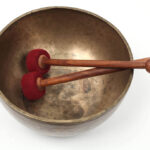Crystal singing bowls and metal or brass singing bowls are two popular options for those interested in sound healing and meditation practices. Each type of bowl has unique characteristics and benefits, making it essential to understand crystal vs metal or brass singing bowls to understand their differences before purchasing.
Crystal Singing Bowls
Singing bowls have been used for centuries in various cultures for meditation, healing, and spiritual practices.
Crystal singing bowls are a relatively new invention, first appearing in the 1980s, and were developed as a modern alternative to traditional metal singing bowls.
Crystal singing bowls create a clear, pure tone believed to have healing properties and are commonly used in sound therapy. In addition, they are believed to be powerful tools for balancing and harmonizing the body’s energy centers, or chakras, and can help promote deep relaxation and stress relief.
Material
Crystal singing bowls are produced from pure quartz crystal, which is crushed into fine quartz powder and then heated to high temperatures. The quartz powder is then moulded into a bowl shape and cooled to form a solid crystal structure. The bowls are available in various colours of clear quartz or frosted quartz finishes.
Size
Quartz crystal singing bowls come in sizes ranging from 6 to 24 inches in diameter. The size of the singing bowls determines the pitch of the sound it produces, with larger bowls producing lower tones and smaller bowls producing higher tones.
Sound and Vibration
Crystal singing bowls produce a pure, clear sound rich in overtones. The bowls are created to vibrate at various frequencies, which helps cleanse the body and mind of negative energy and promote relaxation.
The sound, tone and vibration of crystal singing bowls resonate throughout the body, creating a deep sense of harmony and balance. Crystal singing bowls are also known for their sustain, which means the sound continues after the bowl is struck, allowing for a long, continuous sound that is therapeutic.
When struck or played with a mallet, crystal bowls resonates at a specific frequency, which is measured in hertz (Hz.) The benefits of singing bowls is the frequency or hertz it resonates.
For example, the note C is associated with the root chakra, which is located at the base of the spine and is associated with grounding and stability. A crystal bowl tuned to the note C will produce a frequency of around 256 Hz, which is said to help balance and energize the root chakra.
Similarly, the note D is associated with the sacral chakra, which is located in the lower abdomen and is associated with creativity and sexuality. A crystal bowl tuned to the note D will produce a frequency of around 288 Hz, which is said to help balance and energize the sacral chakra.
By playing different crystal bowls, practitioners of crystal bowl sound therapy can help to balance and harmonize the body’s energy system, promoting healing and well-being.
Our guide Powerful Healing Frequencies relates the hertz frequency and chakra relationship further.
Our top 3 picks of crystal singing bowl sets are:
Metal Singing Bowls
Metal singing bowls are made from various metal alloys, including brass, bronze, and copper or a mixture of metals and are known for their rich, warm tones. They are used in traditional Tibetan and Buddhist ceremonies due to their unique frequencies, overtones, and vibrations to strengthen the mind, promote calmness and inner peace, and are considered sacred.
Material
Different metals are used in singing bowls to produce different sounds. The metal may be tin, copper, bronze, brass, iron, lead, zinc or a metal alloy. Copper bowls are known for their warm, rich sound, while brass bowls produce a brighter, more metallic sound. Bronze bowls are popular due to their balance of warmth and brightness. Iron and lead bowls are less common due to their heavier weight and less resonant sound.
Size
The size of the metal singing bowl determines its pitch and tone. Smaller bowls produce higher pitched sounds, while larger bowls produce lower pitched sounds.
Sound And Vibration
Metal singing bowls produce a complex sound that includes fundamental frequencies and overtones. The fundamental frequency is the main pitch produced by the bowl, while overtones are additional pitches made simultaneously. Metal singing bowls are known for their sustain, or the length of time the sound continues after the bowl is struck, making them popular for those who prefer a deeper, grounding sound.
To learn more about other types of sound healing read our guide Leisure And Sound Healing
Our top 3 choices for metal singing bowls include:
Comparison Of Crystal Vs. Metal Singing Bowls
Sound and Vibration
In sound and vibration, crystal singing bowls are known for producing a clear and pure tone, while metal or brass bowls tend to create a more complex and layered sound. Crystal singing bowls are also said to have a longer sustain, meaning that the sound lingers for longer, which makes them ideal for sound therapy, sound baths, and meditation practices to achieve a deep state of relaxation and focus.
On the other hand, metal or brass singing bowls are popular among musicians and those who use singing bowls for ceremonies. They are also often used in sound healing practices, where the complex overtones are believed to balance the chakras and energy centers of the body.
Benefits
Both crystal and metal or brass singing bowls have their unique benefits. Crystal singing bowls have a higher vibrational frequency, promoting peace and harmony. Metal or brass singing bowls are used for their grounding and centring properties, reduce stress and anxiety, improve focus and concentration, and promote inner peace and calm.
Price
Regarding price, crystal singing bowls are generally more expensive than metal or brass singing bowls, as crystal singing bowls are created from high quality quartz crystal, which is a rare and costly material. Metal or brass singing bowls are more affordable and widely available.
| FEATURE | CRYSTAL SINGING BOWLS | METAL/BRASS SINGING BOWLS |
|---|---|---|
| Material | Quartz crystal | Bronze, brass, copper |
| Sound | Pure tone with high frequency | Complex sound with multiple overtones |
| Durability | Fragile and requires careful handling | More durable and can withstand wear and tear |
| Weight | Lighter compared to metal and brass singing bowls | Heavier compared to crystal singing bowls |
| Price | Generally more expensive due to higher quality and rarity | Less expensive compared to crystal singing bowls |
| Appearance | Translucent and unique visual appeal | Traditional and rustic appearance |
| Chakra alignment | Often used for chakra alignment due to high vibrational frequency | Used for sound healing and meditation |
| Manufacturing process | Specialized process involving heating and molding quartz crystal | Traditional metalworking techniques |
| Origin | Relatively new invention | Rooted in traditional Eastern cultures |
| Availability | Less common and may be harder to find | More widely available compared to crystal singing bowls |
Final Thoughts
Both crystal singing bowls and metal or brass have unique sounds, benefits, and price points. The choice between the two ultimately depends on your intended use for the singing bowl. Whether you’re a sound therapist, musician, or collector, there is a singing bowl out there that is perfect for you.












